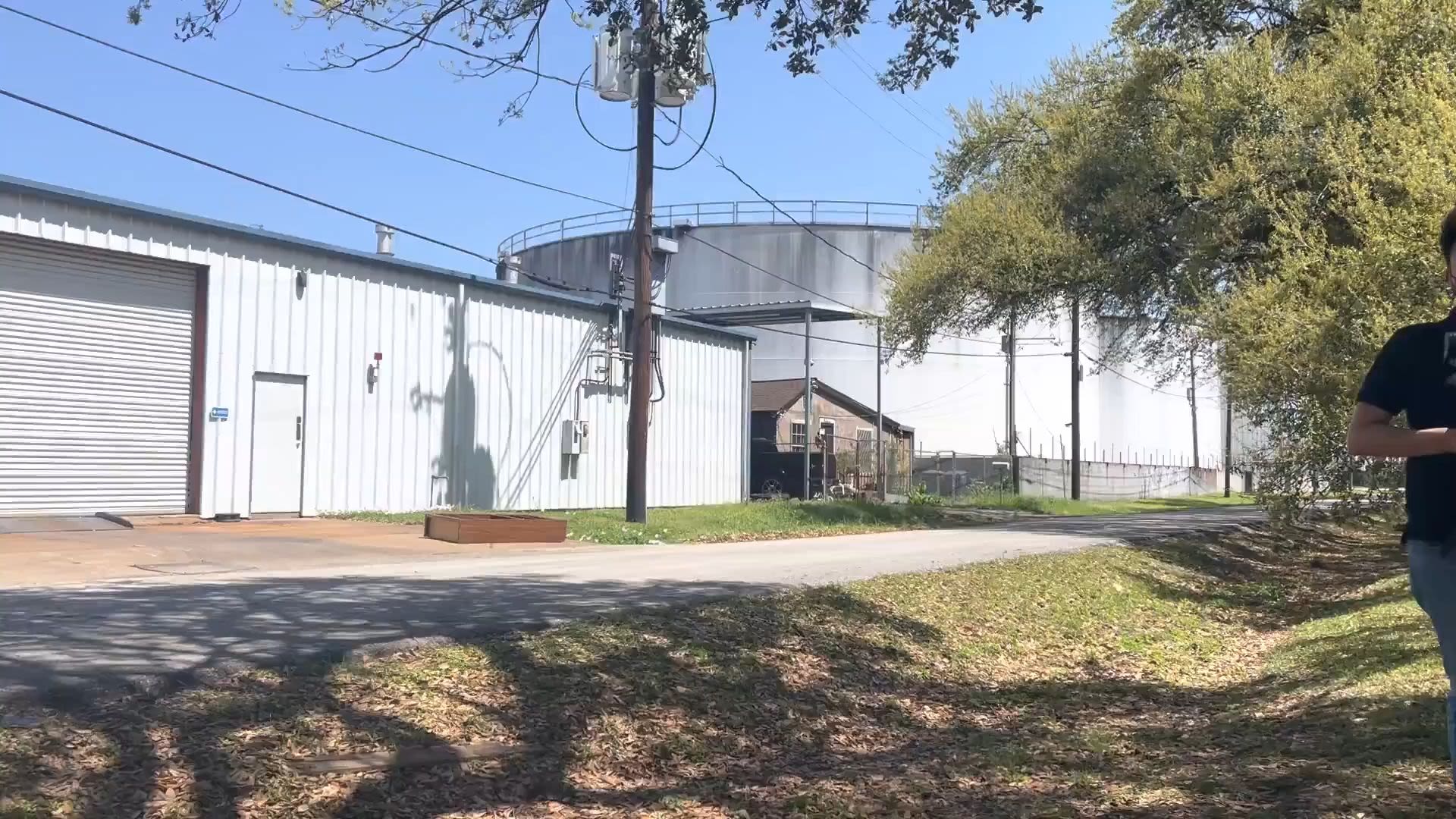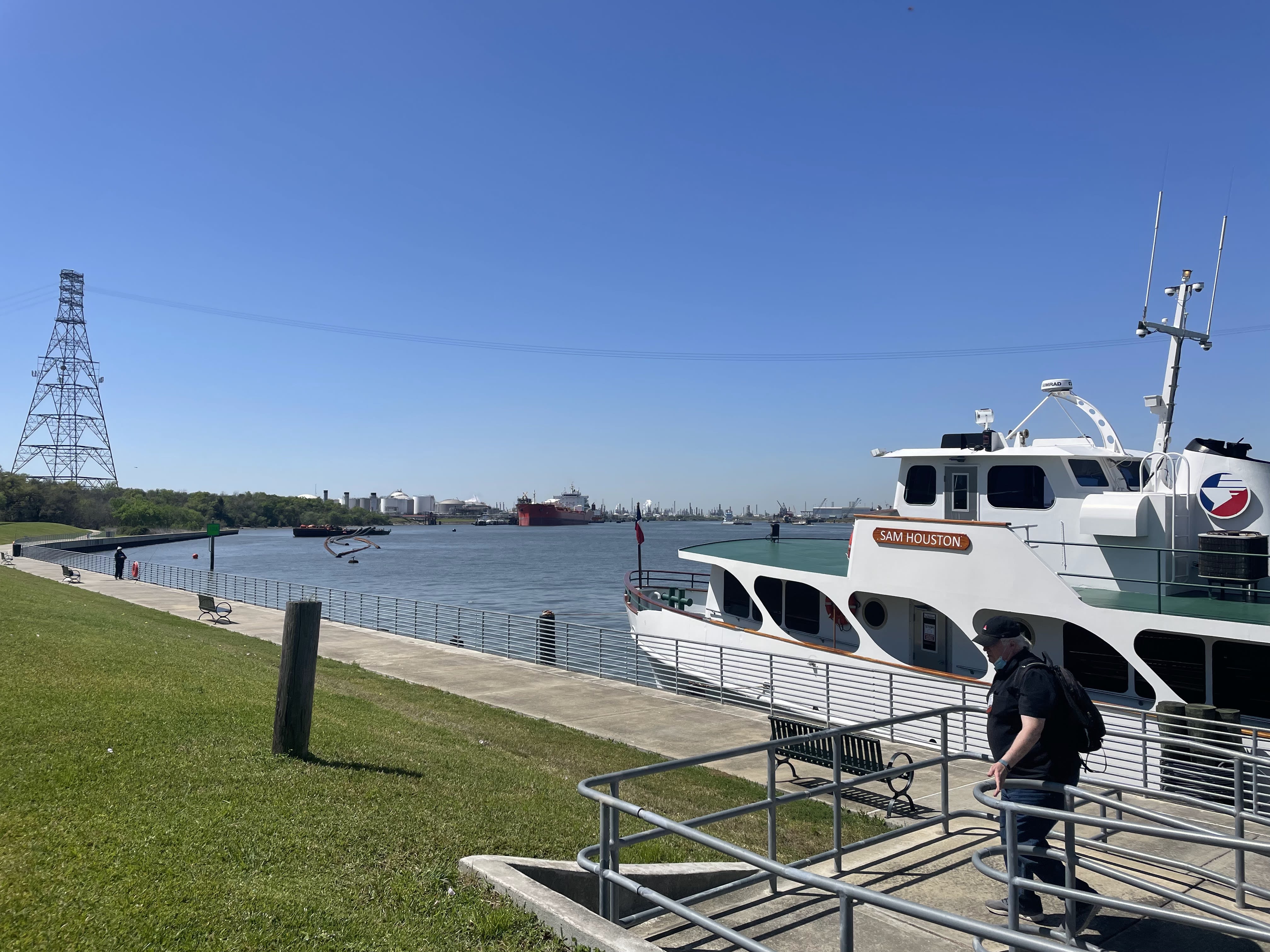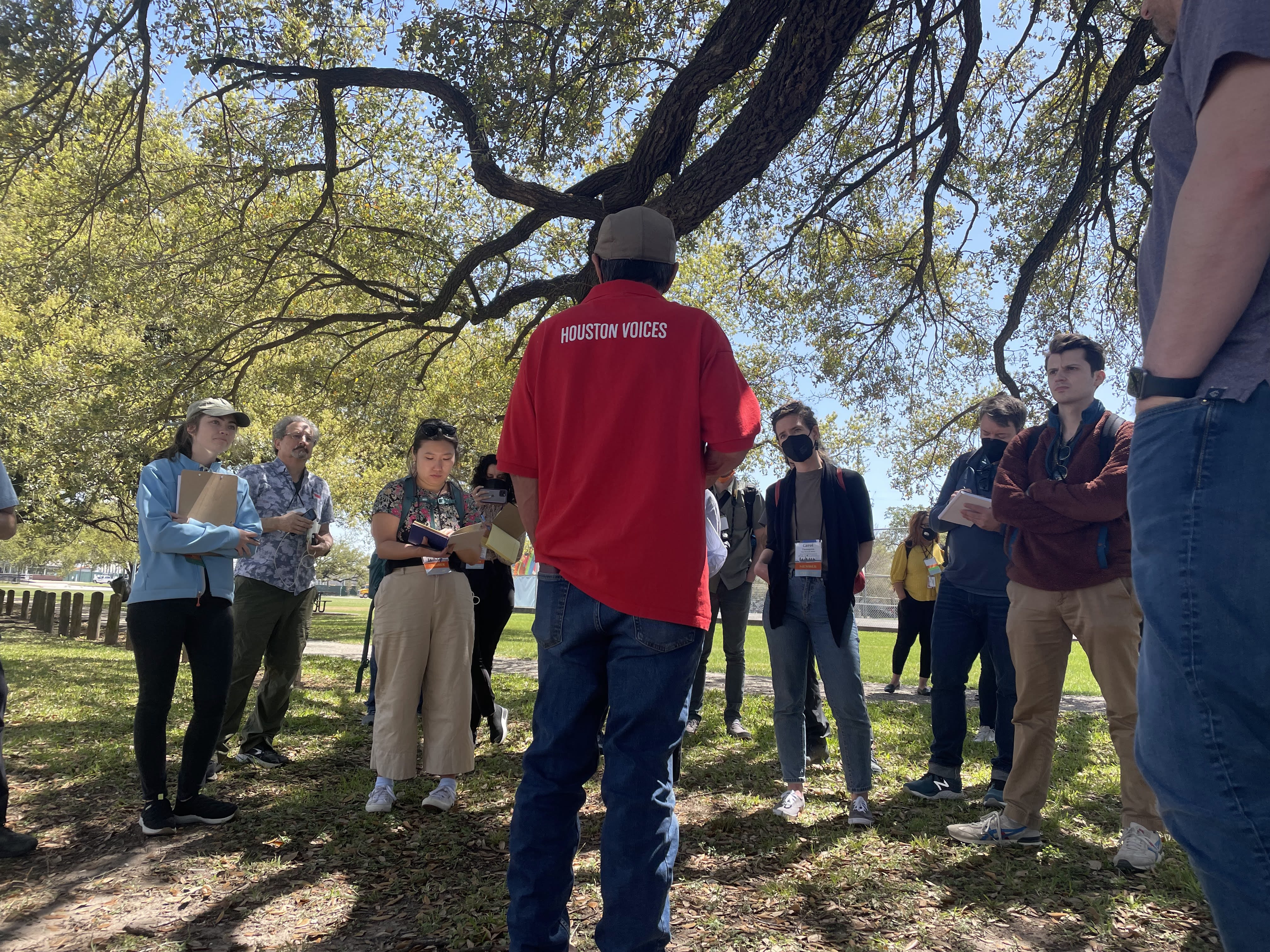Can banks save the planet?
How financial institutions are adapting
practices to stem climate change

It's only a few years old, but the playset has started to lose its color. It was once painted in two stark colors when it was first donated to Hartman Park in the small community of Manchester, Texas, in 2020 as a gesture of goodwill.
Although the colors will continue to fade, the Manchester community will never forget the meaning behind the aqua and orange shades of the playset.
Valero Energy, which has an oil refinery only a few miles from where the playset sits, committed $600,000 in grants to establish the 50/50 Park Partners initiative. The refinery's community relations manager said in a release the company looks to "[enhance] the quality of life in this area through safe, environmentally responsible operations, as well as being a good neighbor."
The playset, visibly surrounded by oil refineries, was a part of that 50/50 Park Partners initiative.
There are a few ways to get to Manchester. One is via a large, chartered, diesel-fueled bus, like when the Society for Environmental Journalists conference sent a group of about 50 journalists to learn more about how low-income communities are impacted by big industry.
Or it might be in a car ride back into Houston after a trip on the free ferry ride down the Houston ship channel, which is lined with the 10 major refineries that process 2.6 million barrels of crude oil each day.
Regardless of how you get there, the smells bombard the senses in the Manchester community. Some of these olfactory scents are sickeningly sweet, while others are reminiscent of burning tar. These smells blend and change with the winds that funnel up the canal from Galveston Bay. On an early April day, some reporters sat and guzzled water to stop the sensation of dizziness that swept through the team.


The communities around Hartman Park — with families predating Valero Energy and the other refineries in the area by nearly 100 years — face the scents, because they have no choice. They also track the pollution daily using retrofitted vans donated to the community after Hurricane Harvey.
Elderly populations and individuals with asthma are recommended to wear a mask if they find the smells overwhelming or sickening.
On the horizon behind the playground where the kids are told it is safe to play perches Texas' largest revenue generator: oil refineries. Advocacy groups in Manchester, such as the likes of T.E.J.A.S led by founder Juan Parras, work to keep more refineries from popping up near the neighborhood and mitigate the health risks already cropping up around the community from air and water pollution.
They call out the oil companies to change.
"We are a sacrifice zone," Parras told the group of journalists, gesturing to the refineries behind the playground. "We want justice, we want environmental justice."

Juan Parras speaking to SEJ reporters (Photo by Garret Reich)
Juan Parras speaking to SEJ reporters (Photo by Garret Reich)
If any change happens, it may be because of something that isn’t readily visible in the channel: the flow of money that keeps the refineries going. Expects in sustainable finance are now targeting the financial institutions that supply the loans and bonds that fund the oil industry.
As one investment group points out, "long-term bank loans are an important source of financing for the construction of refineries."
The oil industry runs on credit, and that means the institutions that supply it keep the oil companies in business.
$4,600,000,000,000
What the top 60 largest banks financed in fossil fuels

In only five years, the world's 60 largest banks financed $4.6 trillion in fossil fuels, starting from when the Paris Agreement in 2015, according to a 2022 Banking on Climate Chaos report.
"Hundreds, if not thousands, of very large financial institutions — often backed by governments — are financing fossil fuels. If we’re going to counteract that, we need a climate-focused, mission-driven financial institution," said Jeff Schub, the executive director of nonprofit green banks incubator and advocacy organization Coalition for Green Capital.
The institutions with the most influence to drastically change the trajectory of climate change — and get the world to the Paris Climate Agreement's goal of 1.5 degrees Celsius — are the ones still investing in it. One can look at Manchester, Texas or even New Haven, Connecticut as examples, microcosms of the issue on a global scale.
New Haven through
the looking glass

Manchester isn't the only American city facing concerns about climate change with solutions financial institution investments can fix.
Three-quarters of the U.S. population concur climate change is a global problem, pushing up against coastal cities with rising ocean levels and leveling out everywhere in between those coastal cities with unpredictable storms that scientists are concerned will worsen.
Coastal cities depend on the ocean for their livelihood and their economic wealth. But, in even a decade, this beloved fixture could push people back from the coastline, forcing them to retreat.
Many people can afford to move inland. Most will even enjoy the tax break and cheaper housing costs of inland states. Yet, that doesn't account for the low-income communities — like the ones in New Haven — who are likely to suffer the fallout.
Nonprofit news organization Climate Central, for one, has scientists tracking flood risk areas globally. Some of the digital maps the teams from the nonprofit built showcase the increase in temperature and how it is projected to affect low-income communities. Others, such as the simulated map pictured below, illustrate the amount of sea-level rise at landmarks around the world at given temperature increases.
"It is sobering to look at some of these images," said Climate Central's Daniel Gilford, who emphasizes the difference between 1.5-degree Celsius increases (the goal of the UN Climate Accords) versus more drastic 3- or 4-degree increases. "Any more than that is really going to change where the water is and what it is doing in places that we care so much about."
Thousands of people recognize the issue and are already drawn to finding a solution. It is, in part, why two high schoolers co-founded a Youth Action Team under climate advocacy group New Haven Climate Movement (NHCM).
Q: Why 1.5 degrees?
A: The National Ocean Services estimates if the global population is unable to slow the increase of carbon emissions and limit the annual temperature rise to 1.5 degrees Celsius "could cause an additional 1.5 - 5 feet (0.5 - 1.5 meters) of sea-level rise for a total of 3.5 - 7 feet (1.1 - 2.1 meters) by the end of this century."
Adrian Huq is a Tufts University student who co-founded the climate advocacy group New Haven Climate Movement (NHCM) when a high school student. Huq uses the pronouns they/them.
"Recycling and pollution to me were some of my largest environmental interests when I was growing up," Huq said, adding in high school, the focus included food share table initiatives and recycling.
Huq joined NHCM in the spring of 2019, when the director Chris Schweitzer asked them to organize a youth climate rally to jumpstart the Youth Action Team. Huq, who had never organized or participated in a strike before, said the purpose was to get youth in the New Haven community involved and learning about local climate change issues.
Soon enough, Hug and high school student Kiana Flores began to oversee NHCN’s youth outreach program.
Both the larger NHCM team and the Youth Action team have gone on to attack a few of the most significant climate issues facing the New Haven community. Huq said flooding and water and air pollution have been a few of these core issues facing low-income populations.
"Flooding is a huge one for New Haven as a whole," Huq said. "Also, there have been multiple environmental, problematic areas in New Haven."
One of these problematic areas is English Station, an abandoned thermal plant sitting unused near the mouth of the Mill River, which spills into the Long Island Sound, Huq pointed out.
Another is the Yale Central Power Plant, which they said is only one of four power plants that Yale uses to generate its electricity. With these concerns comes a heightened risk of health issues in New Haven, especially in low-income communities, Huq said.
"Environmental justice would be creating an ideal world where everyone — regardless of their background — has equal access to not only environmental amenities, such as parks, but also clean air," Huq explains. Everyone, as they point out, deserve a "fair distribution of environmental benefits and not one group getting overburdened by pollution or smoke from incineration."
Funding their efforts is a persistent obstacle.
"It's super hard," they said. "It's also super competitive for environmental nonprofits to get funding so we're always applying for grants."
Schub said the lack of access to funding is a systemic issue. He argues the industry "[has] to finance clean-energy infrastructure the same way we would finance any other construction project. Coal plants have needed and received project finance for decades; the same is now true for solar, wind, efficiency, micro grid, battery storage, and so on."
That is where the banking and related financial businesses come into play as potential partners in the push to eliminate fossil fuels to save the planet.
A trust in banks to do
the right thing

A third of the population trusts its bank a great deal or quite a lot, according to Gallup. Similarly, a separate survey conducted by LendingTree, found almost three-quarters (73%) of people say they trust "their financial institution to keep their best interest in mind," compared to just over half saying the same of the federal government.
At the same time, $4.5 trillion Is needed to finance plans to decarbonize the U.S. energy supply over the next two decades, global energy consultancy firm Wood Mackenzie estimated in a 2019 report.
"The mass deployment of wind and solar generation will require substantial investments in utility-scale storage to ensure grid resilience is maintained," said Head of Global Wind Energy Research Dan Shreve in a report.
It is, in part, why the banks globally founded the Net Zero Banking Alliance in April 2021, ahead of the COP21 conference which took place later in the fall. The alliance — made up of over 100 banks from across 40 countries with over $68 trillion in assets cumulatively — is designed so financial institutions could "align their lending and investment portfolios with net-zero emissions by 2050.
Amalgamated Bank, based in New York City, pioneered the launch of the alliance. Senior Vice President and Chief Sustainability Officer Ivan Frishberg said sustainability is a vigorous conversation in banking, although it may not be moving fast enough to meet goals outlined by the U.N.
"The rhetoric of stakeholder capitalism — the round tables saying, 'we have to serve a greater purpose' — is actually pretty well normalized at this point," Frishberg explained, adding the idea of lowering their carbon footprint can be frightening for large banks who still profit from massive fossil fuel portfolios.
"The banks are not where they need to be," Frishberg said.
Q: What is a carbon footprint? Net-zero?
A: A carbon footprint as defined as the "total amount of greenhouse gas emissions that come from the production, use and end-of-life of a product or service." Individuals, governments and corporations can reduce their carbon footprint to net-zero by producing zero greenhouse gas emissions daily.
Q: What is the difference between operational and portfolio net-zero?
A: Although most non-financial corporations can get to net-zero by reducing their operational carbon footprint, banks must also evaluate their lending portfolio and analyze if the loans they make with businesses and consumers are producing carbon emissions.
Of the 108 global financial institutions which have joined the NZBA, nine are based in the United States: Amalgamated Bank, Bank of America, Blue Ridge Bank, Citi, Climate First Bank, JPMorgan Chase, Morgan Stanley, Goldman Sachs and Wells Fargo. This movement in the industry from top U.S. banks is critical to the sustainability conversation, Frishberg said.
"The pace of change within the industry is staggering," he continued. "Any conversation you had a year before is now the premise of what's possible are doing [and it] has changed dramatically. But, there is a lot to get caught up on."
Frishberg said the work that needs to be done is related to the $3.8 trillion in fossil fuel investments in five years as an example, adding "there is no place [for that] in a net-zero strategy."
A handful of the largest banks in the United States made it to the NZBA list, all with a suite of sustainable promises. Bank of America said it commits to "mobilize $1 trillion by 2030 to accelerate the transition to a low-carbon, sustainable economy" and looks to achieve net-zero greenhouse gas emissions both operationally and financially.
Likewise, Citi said it wants to "accelerate the transition to a low-carbon economy through [a] $500 billion Environmental Finance Goal," JPMorgan promised $2.5 trillion worth of investments "to address climate change and contribute to sustainable development" as it doubles down on a 2030 carbon-intensive target, Morgan Stanley similarly commits to $1 trillion for sustainable solutions and Wells Fargo said its goal "is to achieve net-zero greenhouse gas emissions by 2050, including financed emissions."
At the same time, however, four of the nine U.S. banks in the NZBA were the top contributors to the $3.8 trillion in fossil fuel investments from 2016 to 2021. JPMorgan Chase financed $382 billion in fossil fuels, Citi $285 billion, Wells Fargo $272 billion and Bank of America financed $232 billion. Meanwhile, Morgan Stanley came in twelfth place at $137 billion in fossil fuel financing.

Across the world, protestors are demanding banks to cut off their investments to fossil fuel companies. Rebekah Hinojosa, the Gulf Coast Campaign Representative for the Sierra Club, said at the SEJ Conference in Dallas her team is fighting the importation of gas by protesting French bank BNP Paribas.
"We've successfully got a bank to divest from one of these [liquified natural gas] LNG terminals — called Texas LNG," Hinojosa said, which has plans to bulldoze indigenous lands for the terminal. Hinojosa and other environmental advocacy groups released a report justifying why French bank BNP Paribas should pull out of financing a liquified natural gas (LNG) terminal in south Texas.
"[We are] pressuring the banks who are the ones bankrolling these investments," Hinojosa said.
Q: What is liquified natural gas?
A: Liquified natural gas — also called LNG — is a natural gas that has been cooled and brought to a liquid state. Liquifying natural gas is considered "a way to move natural gas from producing regions to markets" when a natural gas pipeline is not a feasible option, according to the U.S. Energy Information Administration. The energy potential of LNG is considerably greater than natural gas in its gaseous state, according to the U.S. Department of Transportation.
Put banking in sustainable finance

Some institutions slot sustainability at the core of their banking strategy, instead of designate it as a small subsection of their annual reports. Amalgamated Bank, for one, reduced its operational carbon footprint to net-zero and became the first bank in the United States to receive approval for its net-zero targets by the Science Based Targets initiative (SBTi) in March 2022.
The bank's goals would be absolute emissions targets, which would mean Amalgamated would not need to rely on offsets to maintain a net-zero portfolio.
Aspiration — a digital bank that launched in 2013 — is also focused on a net-zero carbon footprint. Cherny told The Financial Brand it not only hasn't invested in fossil fuel projects, but also plants a tree for every time a customer swipes their debit card. On the company's website, customers can use a simulator to calculate how many trees they would figurately 'plant' annually.
"We funded the planting of 50 million trees in just the last year alone, which is as many trees as there are in Central Park being planted every three hours,” CEO Andrei Cherny said. Most of the trees planted are in Africa and South America, he explained, where they "can grow the fastest and have the most immediate climate impacts."
Q: What is the Science Based Target Initiative?
A: The Science Based Target Initiative (SBTi) is a metric with which companies can determine how they perform in comparison to other corporations in their sector as well as help a company determine what its emission reduction targets should look like. "SBTi is working to define a science-based standard for net-zero target setting, to ensure that companies’ targets translate into action that is consistent with achieving a net-zero world by no later than 2050," writes the World Resources Institute team.
Q: What are offsets?
A: If a corporation emits fewer carbon emissions, it can sell carbon offset credits to another company emitting more carbon. However, in order to properly issue carbon offsets, " a project needs to prove it will actually reduce emissions," according to MIT Research Scientist Angelo Gurgel. Examples of projects which can sell carbon offsets are those involving reforestation, renewable energy and carbon-storing agricultural practices.

Not every bank can develop these unique strategies or cut out their fossil fuel investments right away — if they have them. Amalgamated's Frishberg suggests one of the best ways that a financial institution can reduce its carbon footprint and negative impact on the environment is through real estate.
"Real estate is a massive exposure for all of the banks, in both residential and commercial ways," Frishberg said. "Buildings are something like 39% of emissions, and behind buildings are fossil fuels. Heating and cooling and building, you're using electricity that has a significant fossil fuel footprint behind it."
The construction of energy efficient homes is the crux of [RH1] Neighborhood Housing Services of New Haven (NHS), a nonprofit helping local families gain access to affordable housing. Jim Paley, the executive director, started the nonprofit in 1980 in small loft apartment on State Street in New Haven.
As Paley described it, the apartment buildings across the street were desolate when NHS moved into the office in 1980. Over time, Paley watched the street grow, crumble as people left and then grow again over the years, which he attributes to the changing economic state of the city through the decades.
As time went on, Paley's original goal of neighborhood revitalization turned into six key goals: affordable housing development, homeownership counseling, community building and organizing, community sustainability, lending and realty services.
Among other goals, energy efficiency stood out as few low-income families had the money required for that type of home. Paley explained that NHS has always been "conscious of energy efficiency in housing because we knew our target market was low- to median-income families and we knew they could least afford to have energy-efficient homes."
In many cities and states across the country, Frishberg says, there is a strong focus on net-zero infrastructure, both commercially and residentially. New York City, for one, is implementing its Local Law 97. Under the law, buildings over 25,000 square feet would need to meet energy efficiency and greenhouse gas emissions limits, to meet the citywide goals of 40% emission reductions by 2024 and 80% emission reductions by 2050.
Kathy Fay, the NHS director of community sustainability, pointed to the complexity of the issue, explaining while there is funding in the state budget to help with these things, there's no money proportioned for remediation.
Frishberg said financial institutions — when entering into real estate contracts — should say no to any building construction which would involve gas, because it would "[lock] in long-term emissions."
"There is also the retrofitting of buildings on a cyclical basis — buildings always need upgrades and changes," Frishberg said. "Building in the sustainability goals is both and executing on that is a function of policy and finance and changes in the market."
Public transit is another opportunity for financing from private banks, said Michelle Levinson from the World Resources Institute (WRI). Major banks and investment firms, Levinson said, “are interested in adding electrified transportation to their portfolio because investors want to be a part of transportation."
One of Levinson's passion projects with WRI is the Electric School Bus Initiative.
"I like this work because it's at the intersection of different industries," Levinson said. "And I usually say that speaking to electricity or transportation folks about how it's at the intersection, but really my work is with a third point to that triangle — the financial sector."
Larger financial institutions aren't working with individual school districts, Levinson said, but instead hire third-party aggregators who find several school districts looking for electric school bus financing and pool them into one investment. For years before, buses were funded almost exclusively by public grants.
"It's very appealing for that reason, certainly in the school space," Levinson said, adding schools have a very low default rate and are therefore far less risky to a financial institution. "There's this intangible benefit that investors are interested in, which is not monetized — the health benefits to children."
Levinson also works with public green banks — like the Connecticut Green Bank — which offers access to funding through the state. So far, according to Schub, 14 of these green banks exist across the U.S.
"They are helping develop financial products and markets that let greenhouse gas reducing projects find financing," Schub said. "In the U.S., these purpose-built banks have turned each dollar of public funds into $3.40 of private co-investment, creating $3.67 billion of clean energy investment through 2018."
Does the government
play a role?
And if so — how?

The Securities and Exchange Commission (SEC) — a regulating agency overseeing publicly traded companies — is ramping up discussions about climate disclosures in a conversation, which could drastically affect banking's role in fossil fuel investments.
"We believe that additional disclosure requirements may be necessary or appropriate to elicit climate-related disclosures and to improve the consistency, comparability, and reliability of climate-related disclosures," stated a March 2022 SEC proposed rule.
"The required information about climate-related risks would also include disclosure of a registrant’s greenhouse gas emissions, which have become a commonly used metric to assess a registrant’s exposure to such risks," the rule said.
Although the SEC only holds influence over publicly traded banks (of which there were over 600 in 2017), the Federal Deposit Insurance Corporation (FDIC) issued shortly after the SEC's statement its own guidance for climate-risk disclosures.
"The effects of climate change and the transition to reduced reliance on carbon-emitting sources of energy present emerging economic and financial risks to the safety and soundness of financial institutions and the stability of the financial system," said Acting Chairman of the FDIC Martin J. Gruenberg.
All financial institutions — regardless of their stature or geographic location — "are subject to climate-related financial risks," Gruenberg said, adding only banks with asset sizes of $100 billion or more would be subject to the climate-risk disclosures initially. As of April 24, 2022, only 36 U.S. banks have the minimum assets of $100 billion.
"Figuring out the levers of if the government does a small policy change that, if it's in the right place, has a huge impact on the industry and vice versa." O'Callahan. "Fossil fuels have been effective in putting the brakes on anything they don't like. There is a back and forth between policy and industry.
What's in it for the
banking industry?

For financial institutions, establishing a net-zero carbon footprint is a long, unruly process. To replace the revenue generated by their investments in fossil fuels, banks and credit unions must find alternatives to generate loans and investments with a strong return-on-investment (ROI).
Ultimately, however, even the largest financial institutions could feel the positive impacts of being socially responsible. In real estate particularly, banks might find massive opportunities.
"It would be good for banks and credit unions to be discussing the benefits of saving money through energy efficiency, providing more energy loans to anybody — not just low-income people," Schweitzer said.
Consultants at Balkan Green Energy News point out there are also benefits with "reputational kudos and in financial risk reduction," especially if financial regulators pivot and crack down on climate risk reporting.
"Green banks are the future. Climate change can no longer be viewed as just an environmental concern as it affects all economic sectors," said Borislav Kostadinov, Fund Director at Finance in Motion. "But a green transformation needs everyone in the financial ecosystem to play their part."




